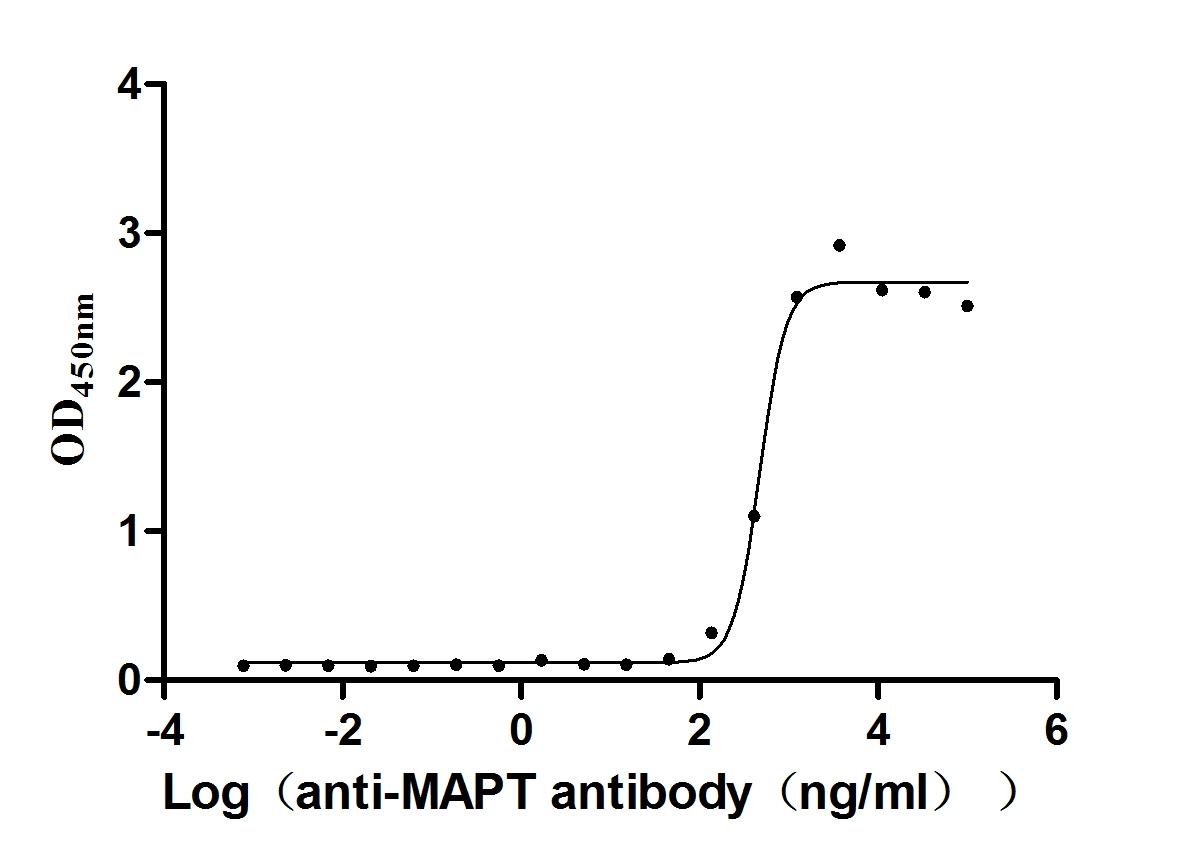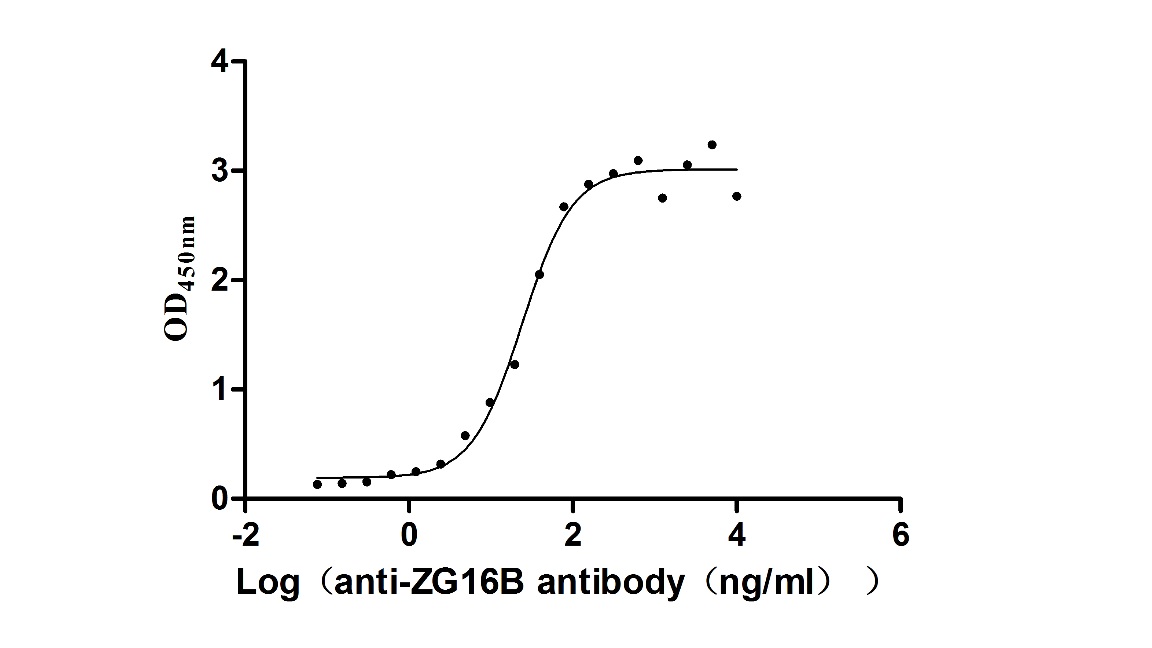Recombinant Mouse Homeobox protein NANOG (Nanog)
-
货号:CSB-YP800371MO
-
规格:
-
来源:Yeast
-
其他:
-
货号:CSB-EP800371MO
-
规格:
-
来源:E.coli
-
其他:
-
货号:CSB-EP800371MO-B
-
规格:
-
来源:E.coli
-
共轭:Avi-tag Biotinylated
E. coli biotin ligase (BirA) is highly specific in covalently attaching biotin to the 15 amino acid AviTag peptide. This recombinant protein was biotinylated in vivo by AviTag-BirA technology, which method is BriA catalyzes amide linkage between the biotin and the specific lysine of the AviTag.
-
其他:
-
货号:CSB-BP800371MO
-
规格:
-
来源:Baculovirus
-
其他:
-
货号:CSB-MP800371MO
-
规格:
-
来源:Mammalian cell
-
其他:
产品详情
-
纯度:>85% (SDS-PAGE)
-
基因名:
-
Uniprot No.:
-
别名:Nanog; Ecat4; Enk; Homeobox protein NANOG; ES cell-associated protein 4; Early embryo specific expression NK-type homeobox protein; Homeobox transcription factor Nanog
-
种属:Mus musculus (Mouse)
-
蛋白长度:full length protein
-
表达区域:1-305
-
氨基酸序列MSVGLPGPHS LPSSEEASNS GNASSMPAVF HPENYSCLQG SATEMLCTEA ASPRPSSEDL PLQGSPDSST SPKQKLSSPE ADKGPEEEEN KVLARKQKMR TVFSQAQLCA LKDRFQKQKY LSLQQMQELS SILNLSYKQV KTWFQNQRMK CKRWQKNQWL KTSNGLIQKG SAPVEYPSIH CSYPQGYLVN ASGSLSMWGS QTWTNPTWSS QTWTNPTWNN QTWTNPTWSS QAWTAQSWNG QPWNAAPLHN FGEDFLQPYV QLQQNFSASD LEVNLEATRE SHAHFSTPQA LELFLNYSVT PPGEI
-
蛋白标签:Tag type will be determined during the manufacturing process.
The tag type will be determined during production process. If you have specified tag type, please tell us and we will develop the specified tag preferentially. -
产品提供形式:Lyophilized powder
Note: We will preferentially ship the format that we have in stock, however, if you have any special requirement for the format, please remark your requirement when placing the order, we will prepare according to your demand. -
复溶:We recommend that this vial be briefly centrifuged prior to opening to bring the contents to the bottom. Please reconstitute protein in deionized sterile water to a concentration of 0.1-1.0 mg/mL.We recommend to add 5-50% of glycerol (final concentration) and aliquot for long-term storage at -20℃/-80℃. Our default final concentration of glycerol is 50%. Customers could use it as reference.
-
储存条件:Store at -20°C/-80°C upon receipt, aliquoting is necessary for mutiple use. Avoid repeated freeze-thaw cycles.
-
保质期:The shelf life is related to many factors, storage state, buffer ingredients, storage temperature and the stability of the protein itself.
Generally, the shelf life of liquid form is 6 months at -20°C/-80°C. The shelf life of lyophilized form is 12 months at -20°C/-80°C. -
货期:Delivery time may differ from different purchasing way or location, please kindly consult your local distributors for specific delivery time.Note: All of our proteins are default shipped with normal blue ice packs, if you request to ship with dry ice, please communicate with us in advance and extra fees will be charged.
-
注意事项:Repeated freezing and thawing is not recommended. Store working aliquots at 4°C for up to one week.
-
Datasheet :Please contact us to get it.
靶点详情
-
功能:Transcription regulator involved in inner cell mass and embryonic stem (ES) cells proliferation and self-renewal. Imposes pluripotency on ES cells and prevents their differentiation towards extraembryonic endoderm and trophectoderm lineages. Blocks bone morphogenetic protein-induced mesoderm differentiation of ES cells by physically interacting with SMAD1 and interfering with the recruitment of coactivators to the active SMAD transcriptional complexes. Acts as a transcriptional activator or repressor. Binds optimally to the DNA consensus sequence 5'-TAAT[GT][GT]-3' or 5'-[CG][GA][CG]C[GC]ATTAN[GC]-3'. Binds to the POU5F1/OCT4 promoter. Able to autorepress its expression in differentiating (ES) cells: binds to its own promoter following interaction with ZNF281/ZFP281, leading to recruitment of the NuRD complex and subsequent repression of expression. When overexpressed, promotes cells to enter into S phase and proliferation.
-
基因功能参考文献:
- myoblasts that were primed by NANOG maintained their differentiation capacity for 20days after NANOG withdrawal PMID: 29245050
- USP21 interacts with, deubiquitinates and stabilizes Nanog, and therefore maintains the protein level of Nanog in mouse embryonic stem cells to maintain stemness. PMID: 27886188
- the epigenetic status of Oct4 and Nanog genes confirm that pre-induced pluripotent stem cells belong to an RVTg+OCT4+NANOG- state PMID: 27622636
- In mouse embryonic stem cells, Cops2 binds to Nanog protein and prevent the degradation of Nanog by the proteasome. PMID: 27226076
- Tip110 deletion impaired embryonic and stem cell development involving downregulation of stem cell factors Nanog, Oct4, and Sox2. PMID: 28436127
- Loss of phosphorylation enhances NANOG activity in reprogramming. Mutation S65A alone has the most significant impact on increasing NANOG reprogramming capacity. PMID: 28457890
- Nanog, Oct4 and Tet1 interplay in establishing stem cell pluripotency has been described. PMID: 27146218
- Members of the SIN3A/HDAC2 corepressor complex are enriched in an extended NANOG interactome. PMID: 28199843
- Functional studies revealed that knockdown of Nanog eliminated the mESC self-renewal-promoting ability of Sp5. Finally, we demonstrated that the self-renewal-promoting function of Sp5 was largely dependent on its zinc finger domains PMID: 28961274
- Otx2-mediated Nanog regulation contributes to the integrity of the embryonic stem cell state and cell lineage specification in preimplantation development. PMID: 27292645
- Maintenance of pluripotency is regulated by a network of transcription factors coordinated by Oct4, Sox2, and Nanog; Trim24 significantly improved efficiency of cellular reprogramming, demonstrating its direct functionality in establishing pluripotency. PMID: 27773674
- studies highlight a new hypoxia-induced pathway in which NANOG activates BNIP3L expression, contributing to autophagy induction in hypoxic tumor cells and their resistance to killing by CTL PMID: 28093523
- Genetic reporters can compromise the behavior of important pluripotency-sustaining positive feedback loops, and induce a bifurcation in the underlying dynamics that gives rise to heterogeneous Nanog expression patterns in reporter cell lines that are not representative of the wild-type; findings help explain the range of published observations of Nanog variability and highlight the problem of measurement in live cells. PMID: 28636920
- Here the s couple mutagenesis with functional and dimerization assays to show that the number of tryptophans within the tryptophan repeat is linked to the strength of homodimerization, Sox2 heterodimerization and self-renewal activity. PMID: 27939294
- In mouse model of acute uterine injury, Nanog homebox (NANOG) expression reached a peak at 6 h, while sex-determining region Y-box2 (SOX2) and octamer-binding protein 4 (OCT4) peaked later at 12 h after lipopolysaccharide (LPS) treatment. PMID: 28253866
- NANOG as a key regulator connecting the pluripotency network with constitutive heterochromatin organization in mouse embryonic stem cells. PMID: 27125671
- Data indicate that Nanog homeobox protein is important for the effects of reprogramming media. PMID: 26975336
- Nanog enhances proliferation of fibroblasts through transcriptional regulation of cell cycle inhibitor p27 gene. PMID: 26795560
- The different embryonic stem cells Nanog-expressing populations differ in their differentiation propensities. Nanog upregulation is not well correlated to Oct4, Sox2 and Klf4 expression, or cell cycle phase. PMID: 26760119
- 1After the 32-cell stage, when embryos form the blastocyst cavity, Nanog expression was upregulated mainly in ICM cells while it was repressed in the future primitive endoderm lineage in an FGF signaling-dependent manner in the later stages PMID: 26660234
- Nanog is able to transform normal somatic cells into tumor cells. PMID: 26733157
- NANOG represses mitochondrial oxidative phosphorylation genes, as well as reactive oxygen species generation, and activates fatty acid oxidation to support tumor initiating cell self-renewal and drug resistance. PMID: 26724859
- The cellular reprogramming-promoting function of mitoflashes occurs via the upregulation of Nanog expression. PMID: 26549484
- the existence of three stable steady states for Nanog levels, which are the same in all the different conditions of the cell-culture medium. PMID: 23054952
- NANOG binds to GLI1 and GLI3 proteins and represses Hedgehog-mediated transcription. PMID: 26797124
- Tgif1 counterbalances the activity of core pluripotency factors, Oct4, Sox2, and Nanog, in mouse embryonic stem cells. PMID: 26411691
- TLR4 signaling via NANOG cooperates with STAT3 to activate Twist1 and promote formation of tumor-initiating stem-like cells in livers of mice. PMID: 26582088
- Pluripotency transcription factors Nanog and Oct4 positively modulate Sod2 gene transcription in induced pluripotent stem cells. PMID: 26642061
- NANOG alone induces germ cells in primed epiblast in vitro by activation of enhancers PMID: 26751055
- Forced expression of Nanog (and Esrrb) resulted in the dispensability of nucleostemin expression in embryonic stem cells. PMID: 25522312
- Dax1 and Nanog have roles in stabilizing mouse embryonic stem cells and induced pluripotency PMID: 25284313
- Data position Cited2 within the pluripotency gene regulatory network by defining Nanog, Tbx3, and Klf4 as its direct targets and demonstrate that the defects caused by Cited2 depletion are, at least in part, rescued by Nanog constitutive expression. PMID: 25377420
- immunoprecipitation. Our data provide new insights into the expanded regulatory circuitry that coordinates Nanog expression. PMID: 26296469
- NANOG is selectively expressed in stratified epithelia, most notably in the oesophagus where the Nanog promoter is hypomethylated. PMID: 24979572
- Stochastic promoter activation significantly affects the Nanog expression variability in mouse embryonic stem cells. PMID: 25410303
- prolonged expression upon differentiation in METTL3-depleted embryonic stem cells PMID: 25456834
- BRD4 associates with BRG1, a key regulator of embryonic stem cell self-renewal and pluripotency, in the Nanog regulatory regions to regulate Nanog expression. PMID: 25146928
- Despite downregulation of tumor suppressors and increased proliferation, ectopic Nanog expression did not lead to tumor formation. PMID: 25173648
- Nanog may be an important mediator of reprogramming, it is not required for establishing pluripotency in the mouse, even under standard conditions. PMID: 24527385
- Myst2-mediated histone acetylation may be required for recruitment of Oct4 to the Nanog promoter PMID: 25743411
- Taken together, our results suggest that Nanog positively regulates Zfp57 expression in multiple types of cells. PMID: 25445595
- observed cell cycle-regulation of Nanog expression, and not Oct4, reaching high levels prior to G1/S transition, finely mirroring Cyclin E1 fluctuations PMID: 24695638
- Nuclear transfer alone affords no immediate transition from a somatic to an Oct4- and Nanog-positive gene expression pattern, unless DNA replication is also in place within the mouse ooplasm. PMID: 24836291
- Nanog protein promotes pluripotency by inhibiting endodermal specification. PMID: 24681518
- Nanog functions in conjunction with mesenchymal factors Snai1 and Snai2 in the transcriptional regulation of pluripotency-associated genes and miRNAs during the Nanog-driven reprogramming process. PMID: 25240402
- This network was rearranged during differentiation and restored in induced pluripotent stem cells. A large fraction of Nanog-interacting loci were bound by Mediator or cohesin in pluripotent cells. PMID: 23665121
- Data suggest a role for Vc in Nanog regulation networks and reveal a novel role for STAT2 in regulating Nanog expression. PMID: 23963652
- Foxa1 recruited Grg3 to the Nanog promoter -2kb upstream region and switched the promoter to an inactive chromatin status represented by typical modifications in histone H3. PMID: 24803390
- SHP-1 participated in regulation of Nanog expression. PMID: 24466030
- Nanog co-regulated by Nodal/Smad2 and Oct4 is required for pluripotency in developing mouse epiblast. PMID: 24929238
显示更多
收起更多
-
亚细胞定位:Nucleus.
-
蛋白家族:Nanog homeobox family
-
组织特异性:Not expressed in oocytes and spermatogonia (at protein level). Not expressed in many somatic organs, ovary, testis, fibroblast and hematopoietic cell lines.
-
数据库链接:
KEGG: mmu:71950
STRING: 10090.ENSMUSP00000012540
UniGene: Mm.485537
Most popular with customers
-
Recombinant Human Glypican-3 (GPC3) (G537R), partial (Active)
Express system: Mammalian cell
Species: Homo sapiens (Human)
-
Recombinant Mouse Microtubule-associated protein tau (Mapt) (Active)
Express system: Mammalian cell
Species: Mus musculus (Mouse)
-
Recombinant Macaca fascicularis Trophoblast glycoprotein (TPBG), partial (Active)
Express system: Mammalian cell
Species: Macaca fascicularis (Crab-eating macaque) (Cynomolgus monkey)
-
Recombinant Human Dickkopf-related protein 1 (DKK1) (Active)
Express system: Mammalian cell
Species: Homo sapiens (Human)
-
Recombinant Macaca fascicularis zymogen granule protein 16 homolog B (ZG16B) (Active)
Express system: Mammalian cell
Species: Macaca fascicularis (Crab-eating macaque) (Cynomolgus monkey)
-
Recombinant Human Desmoglein-2 (DSG2), partial (Active)
Express system: Mammalian cell
Species: Homo sapiens (Human)
-
Recombinant Human CUB domain-containing protein 1 (CDCP1), partial (Active)
Express system: Mammalian cell
Species: Homo sapiens (Human)
-
Recombinant Human Serine/threonine-protein kinase receptor R3 (ACVRL1), partial (Active)
Express system: Baculovirus
Species: Homo sapiens (Human)


-AC1.jpg)


-AC1.jpg)














